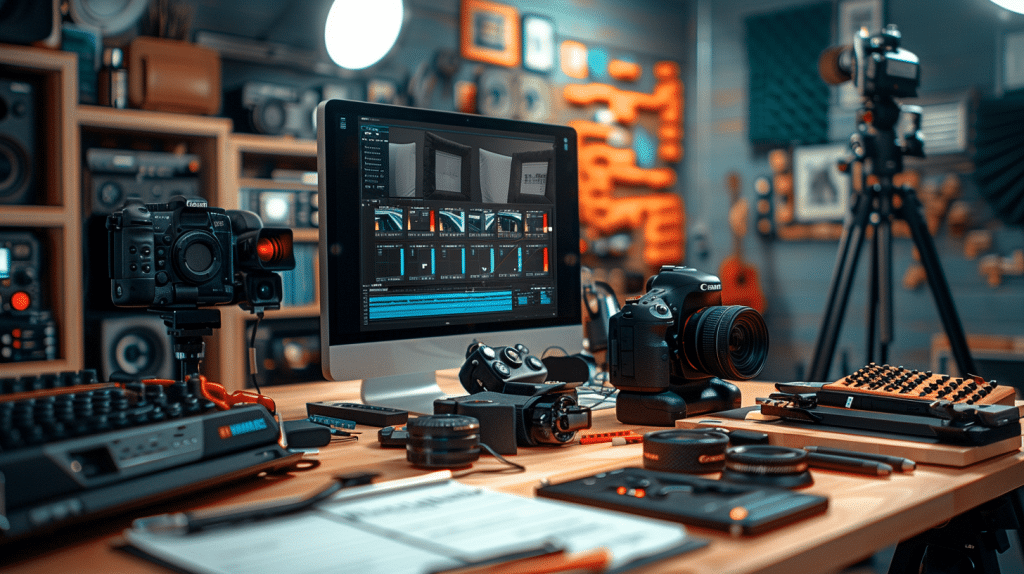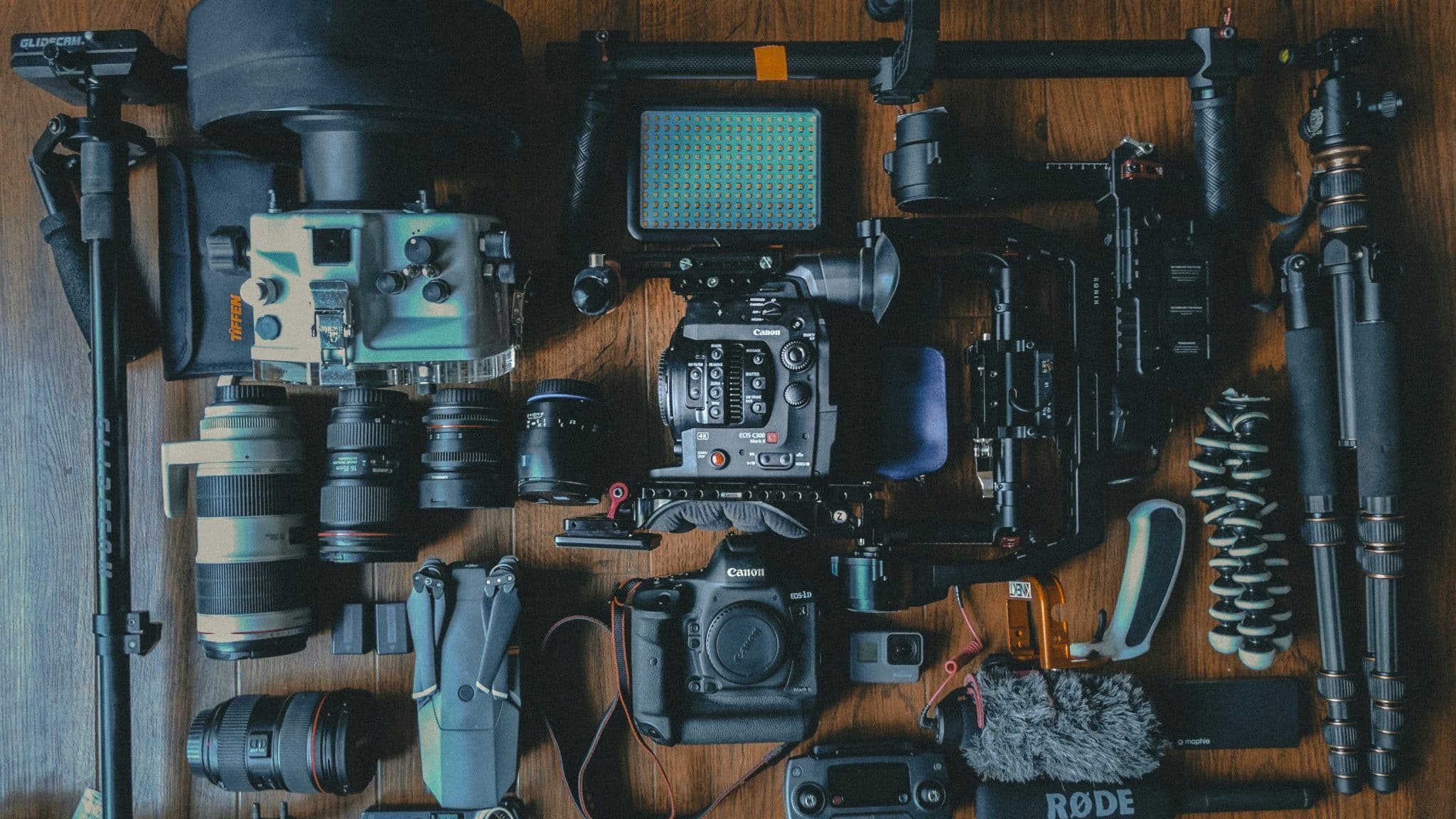Be Prepared: Essential Video Shoot Checklist

When you’re gearing up for a video shoot, having a detailed video shoot checklist is your best ally.
You’ll want to cover everything from pre-production planning to post-shoot review to guarantee a smooth process.
Start with script development and move on to scouting locations and assembling your crew.
Don’t forget to double-check your equipment and set your timeline.
These steps are essential, but what happens when things don’t go as planned?
Having backup plans ready can save the day.
So, how can you make sure you’ve got all your bases covered?
Table of Contents
Pre-Production Planning

Pre-production planning is vital because it sets the foundation for a successful video shoot by ensuring all logistics, creative elements, and technical requirements are meticulously organized.
To start, you should focus on script development. A well-crafted script will guide your shoot, providing clear dialogue, scene descriptions, and essential actions. Make sure every detail is outlined, so there’s no confusion on the day of the shoot.
Next, move on to storyboard creation. This visual representation of your script will help you and your team visualize each shot and scene.
Storyboarding breaks down the script into individual frames, detailing camera angles, movements, and important visual elements. It’s like a roadmap for your video, ensuring everyone is on the same page.
Both script development and storyboard creation are vital steps. They allow you to anticipate potential challenges and address them before they become issues. When these elements are well-prepared, you can focus on bringing your vision to life without unnecessary hiccups.
Don’t skip these steps; they’re the backbone of your project and will save you time and stress as you move forward with your shoot.
Scouting Locations

When scouting locations, make sure to identify ideal lighting conditions to enhance your video quality.
Assess ambient noise levels to avoid disruptions during filming.
Evaluate the site’s accessibility and secure any necessary permissions in advance.
Identify Optimal Lighting Conditions
Scouting locations to identify ideal lighting conditions guarantees that your video captures the highest visual quality possible. Start by considering the golden hour, which occurs just after sunrise and before sunset.
During this time, the natural light is soft and warm, maximizing favorable shadows and creating a visually appealing look. Make sure to visit your chosen location during these times to see how the light interacts with the environment and your subjects.
Next, evaluate how light diffusion can impact your shoot. Natural light can be diffused by clouds, trees, or buildings to create a softer illumination.
If the natural setting doesn’t offer sufficient diffusion, consider bringing portable diffusers or reflectors to control the light. This step assures your subjects are well-lit without harsh glare or unwanted shadows.
When scouting, look for areas with consistent lighting throughout the day to avoid drastic changes during your shoot. Pay attention to how the light shifts in your location, noting any obstructions or reflective surfaces that might affect your setup.
Assess Ambient Noise Levels
As you scout for ideal lighting conditions, it’s equally important to evaluate ambient noise levels to guarantee your audio quality matches your visual standards.
First, visit the location at the same time of day you plan to shoot. Listen for traffic, construction, and other disruptive sounds that could interfere with your recording.
Next, consider noise reduction techniques. Identify potential noise hotspots and think about whether they can be minimized or avoided entirely. For instance, if you’re near a busy road, find a quieter spot further away.
Soundproofing strategies can be invaluable.
Bring along items like blankets, foam panels, or even heavy curtains to dampen sound reflections and reduce echo. If you’re shooting indoors, closing windows and doors can also help isolate the area from external noise.
Additionally, test your recording equipment on-site to make sure it captures clear audio without background interference. Use directional microphones, which can focus on specific sounds while filtering out ambient noise.
Evaluate Accessibility and Permissions
How can you guarantee your chosen location is both accessible and legally permissible for your video shoot? Start by evaluating accessibility and permissions meticulously.
First, make sure you secure all necessary legal contracts to avoid any legal complications.
Contact property owners or local authorities to understand the permissions required. Make certain the location complies with legal regulations, especially if it’s a public space or historical site.
Next, don’t overlook disability accommodations. The location should be accessible to all crew members and talent.
Check for ramps, elevators, and accessible restrooms. If your shoot involves actors or crew members with disabilities, ensure they can navigate the space comfortably.
Here’s a quick checklist to streamline this process:
- Obtain Legal Contracts: Secure written permissions from property owners or local authorities.
- Verify Permits: Check if you need additional permits for public or restricted areas.
- Assess Accessibility: Confirm the location has necessary accommodations like ramps and accessible restrooms.
- Scout Security Measures: Confirm the safety and security protocols of the location.
- Review Local Regulations: Understand and comply with local filming laws and ordinances.
Assembling Your Crew

When assembling your crew, first define each crew member’s role to guarantee everyone knows their responsibilities.
Then, schedule crew availability to make sure all necessary personnel can be present on the shoot day.
This organized approach will help your video shoot run smoothly and efficiently.
Define Crew Roles
To guarantee a smooth video shoot, it’s vital to clearly define each crew member’s role and responsibilities.
Proper project management and task allocation are key to making sure that everyone knows their duties and can execute them efficiently. By explicitly outlining each role, you prevent confusion and foster a collaborative environment.
Here are some critical roles to define:
- Director: Directs the overall vision, coordinates with the crew, and makes creative decisions on set.
- Producer: Manages logistics, oversees budget, and ensures the project stays on schedule.
- Camera Operator: Handles the camera equipment, frames shots, and captures the visual essence of your project.
- Sound Engineer: Manages audio equipment, records sound, and ensures high-quality audio production.
- Lighting Technician: Sets up and manages lighting to create the desired mood and ensure proper exposure.
Clearly defined roles streamline communication and enhance efficiency. Each crew member knows whom to report to and what’s expected of them.
This clarity leads to a more organized shoot, reducing the likelihood of errors and delays.
Schedule Crew Availability
Often, it’s crucial to coordinate and verify each crew member’s availability well in advance to guarantee a smooth video shoot.
Start by creating a detailed schedule that outlines the dates and times of the shoot. Share this schedule with your crew as early as possible to identify any availability conflicts.
Effective crew coordination means using tools like shared calendars, project management software, or even a simple spreadsheet. These tools help you track everyone’s availability and make necessary adjustments. If someone has a conflict, address it immediately to avoid last-minute disruptions.
Communicate clearly and regularly. Send reminders as the shoot dates approach and confirm attendance a few days before the shoot.
This ensures everyone is on the same page and minimizes the risk of unexpected absences.
Additionally, always have a backup plan. Identify alternative crew members who can step in if someone becomes unavailable last minute.
Maintaining a list of reliable freelancers can save your project from potential delays.
Equipment Checklist

Before you begin your video shoot, make sure you have all the necessary equipment ready and in good working condition. Proper gear maintenance and thorough equipment testing are essential to avoid any unexpected issues that could disrupt your shoot.
Here’s a detailed checklist to make sure you’ve got everything covered:
- Camera and Lenses: Confirm your camera is functioning correctly and that you have the appropriate lenses for your shoot. Check for dust and clean the lenses if necessary.
- Tripods and Stabilizers: Verify that your tripods and stabilizers are sturdy and free from any damage. Test the stability and adjust settings as needed.
- Lighting Gear: Inspect your lights, stands, and modifiers. Ensure bulbs are working and carry spares. Test the lighting setup to verify it meets your needs.
- Audio Equipment: Check microphones, audio recorders, and headphones. Test for sound quality and make sure batteries are fully charged or have spares on hand.
- Batteries and Chargers: Gather all necessary batteries and chargers for your cameras, lights, and audio gear. Confirm everything is fully charged and operational.
Scheduling and Timelines

Developing an efficient video shoot schedule guarantees that every team member understands their responsibilities and timelines, reducing the risk of delays. Start by listing all tasks, including pre-production, shoot days, and post-production activities.
Assign deadlines for each task and make sure everyone is aware of their roles. Use a project management tool to maintain an organized timeline and facilitate communication among the team.
Next, build in some buffer time for unexpected challenges. Timeline adjustments are inevitable, so having a bit of wiggle room can save you from falling behind. Make sure to communicate any changes promptly to avoid confusion.
Deadline flexibility is essential, especially when coordinating with multiple team members or external vendors. If someone can’t meet a deadline, adjust the schedule accordingly and notify everyone involved. This proactive approach keeps the project moving smoothly and minimizes stress.
Lastly, hold regular check-ins to monitor progress and address any issues before they escalate. These meetings are an opportunity to make necessary timeline adjustments and ensure everyone is on the same page.
By keeping the schedule clear, flexible, and well-communicated, you’ll set the stage for a successful video shoot.
On-Set Protocols

Establishing clear on-set protocols guarantees that everyone knows their roles and responsibilities, creating a smooth and efficient workflow.
Start by holding a brief meeting with your team to outline the day’s schedule, specific tasks, and expectations. This assures that everyone is on the same page and aware of their duties.
To enhance your on-set efficiency, consider these key protocols:
- Wardrobe choices: Make sure that all wardrobe selections are finalized and approved before the shoot day. This minimizes delays and keeps the shoot on schedule.
- Catering options: Coordinate catering to provide timely meals and snacks. Keeping the crew well-fed boosts morale and maintains energy levels.
- Clear communication: Use walkie-talkies or a dedicated communication app to keep everyone connected and informed of any changes or updates during the shoot.
- Time management: Stick to the timeline as closely as possible. Allocate specific time slots for each scene and monitor progress to avoid overruns.
- Cleanliness and order: Maintain a clean and organized set. Assign a team member to oversee cleanliness, ensuring that props and equipment are in their designated places.
Backup Plans

Having a solid backup plan guarantees that unforeseen issues won’t derail the entire production. Start by identifying potential problems that could arise, such as inclement weather or equipment failure.
For instance, if you’re shooting outdoors, always have alternative locations in mind. Scout these spots beforehand to confirm they’re suitable for your needs and easily accessible.
Next, create detailed contingency plans for each possible issue.
If a critical piece of equipment fails, have spares on hand or know where you can quickly rent replacements. Similarly, if a key team member falls ill, have a list of backups who can step in on short notice.
Communication is also vital. Make sure everyone on the team knows the backup plans and their roles should an issue arise.
Share contact information and emergency procedures in advance. This will save precious time and reduce stress during the shoot.
Preparation extends to your schedule as well. Build in buffer time for unexpected delays, ensuring you stay on track even if something goes wrong.
With well-thought-out backup plans, you’ll maintain control and keep your production running smoothly.
Post-Shoot Review

After completing the shoot, it’s crucial to conduct a thorough post-shoot review to evaluate the footage and overall production quality. This step guarantees you haven’t missed any critical shots and confirms that the footage aligns with the project’s goals.
Start by organizing all your clips and reviewing them systematically. Look for any technical issues like poor lighting, shaky camera work, or audio problems.
Next, involve your team in the footage review. Their input can be invaluable in identifying strengths and weaknesses.
Also, gather client feedback at this stage to make sure their vision has been captured accurately. This not only builds trust but also provides an opportunity for any necessary changes before final editing.
To help you enjoy this process and make it effective, consider the following:
- Organize Footage: Sort clips by scenes or categories for easy navigation.
- Technical Checks: Look for issues like poor lighting, shaky footage, or bad audio.
- Team Input: Review the footage with your team to catch any overlooked details.
- Client Feedback: Share initial cuts with the client to ensure their vision is met.
- Backup Footage: Make sure all footage is backed up in multiple locations to prevent data loss.
Frequently Asked Questions
How Do You Manage Unexpected Weather Changes During a Shoot?
When unexpected weather changes hit during a shoot, you need to act fast. First, have backup locations ready to go. This way, you can quickly move your team and equipment.
Second, use portable shelters to protect your gear and crew from rain or strong winds.
Always check the weather forecast beforehand, but being prepared with these strategies guarantees you tackle any surprises efficiently and keep your shoot on track.
What Steps Do You Take to Ensure Data Security During Production?
To guarantee data security during production, you should implement cloud backups to store your footage safely.
Use encryption protocols to protect your data from unauthorized access.
Regularly update your security software and restrict access to sensitive information.
Always back up your data at multiple locations and test your recovery processes to verify their effectiveness.
How Do You Handle Catering and Meals for the Crew on Set?
You manage catering and meals for the crew by first collecting information on dietary restrictions and food allergies from everyone.
Plan a diverse menu that includes options for all needs.
Coordinate with a reliable catering service, making sure they understand the importance of avoiding cross-contamination.
Have snacks and drinks readily available throughout the day.
Regularly check in with the crew to guarantee their dietary needs are being met and adjust if necessary.
What Are the Best Practices for Obtaining Necessary Permits for Shooting?
To obtain necessary permits for shooting:
Start by identifying the jurisdiction of your location. Contact the local film office to understand requirements and permit fees.
For shooting on public property, make sure you submit applications well in advance. Double-check all documentation and follow up regularly.
Keep copies of all permits on hand during the shoot. This organized approach guarantees compliance and avoids disruptions.
How Can You Enhance Team Communication and Collaboration During a Video Shoot?
Think of your team as a well-oiled machine; every part must work together seamlessly.
Start with regular team meetings to guarantee everyone’s aligned. Use communication tools like Slack or Trello to keep everyone in the loop.
Make sure to designate clear roles and responsibilities so no one’s stepping on each other’s toes.
This will enhance team communication and collaboration, making your video shoot smooth and efficient.
Share:
Search our blog:
Follow us on:
